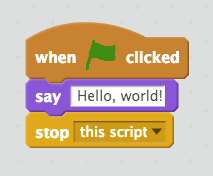Snap! (programming language)
 | |
| Paradigm | object-oriented, educational, event-driven |
|---|---|
| Designed by | Brian Harvey and Jens Mönig |
| Developer | Jens Mönig |
| First appeared | 2011 |
| Stable release | 4.0.2 / August 6, 2015 [1] |
| Typing discipline | dynamic |
| Implementation language | Squeak (BYOB), JavaScript (Snap!) |
| OS | Cross-platform |
| License | AGPL |
| Filename extensions | .ypr, .ysp (BYOB); .xml (Snap!) |
| Website |
snap |
| Influenced by | |
| Scratch, Scheme, Logo, Smalltalk | |
| Influenced | |
| BeetleBlocks, Snapi | |
Snap! is a free, blocks- and browser-based educational graphical programming language that allows students to create interactive animations, games, stories, and more, while learning about mathematical and computational ideas. Snap! was inspired by Scratch, but also targets both novice and more advanced students by including and expanding Scratch's features.
Snap! 4.0 is entirely browser-based with no software that needs to be installed on the local device.
History
Snap! 4.0 and its predecessor BYOB were developed by Jens Mönig for Linux, OS X or Windows,[2][3] with design ideas and documentation provided by Brian Harvey[4][5] from University of California, Berkeley and have been used to teach "The Beauty and Joy of Computing" introductory course in computer science (CS) for non-CS-major students.[6] As of December 2014, 100 New York City (NYC) high schools will introduce University of California at Berkeley’s “Beauty and Joy of Computing” as a new AP Computer Science Principles course in 2015, using Snap!.[7]
Earlier, desktop-based 3.x version's open-source code is available under a license that allows modifying for non-commercial uses and can be downloaded from the UC Berkeley website[8] or CNET's Download.com and TechTracker download page.[9][10] The source code is Affero General Public License (AGPL) licensed and is available for download within Snap! itself and on Github.[11]
Platforms
Snap! 4.0 runs on iOS, OS X, Windows, and Linux devices, because it is implemented in JavaScript using an HTML5 Canvas application programming interface (API). In contrast, Scratch 2.0 was written in Adobe Flash, so it cannot run on Linux.
User interface

The screen areas are arranged in the way they used to be in Scratch prior to the version 2.0, with the blocks palette in the left area, the scripts area associated with a selected sprite in the middle of the screen, and the stage area with sprites thumbnails listed below it in the right area of the screen.
The "stage area" is featuring the results (i.e. animations, turtle graphics etc., everything either in small or normal size, full-screen also available). Below it are listed all available sprites' thumbnails.
With a sprite thumbnail selected, blocks of commands can be applied to it by dragging them from the Blocks Palette onto the middle area of the screen, containing all the scripts associated with the selected sprite. Available blocks are listed and categorized in the Motion, Looks, Sound, Pen, Control, Sensing, Operators, and Variables groups as shown in the table below. Each can also be individually tested under different conditions and parameters via double-click.
| Category | Notes | Category | Notes | ||
|---|---|---|---|---|---|
| Motion | Moves sprites and changes angles | Control | If statements, events, and loop structures | ||
| Looks | Controls visibility, costumes, and output | Sensing | All sprite hit detection and user input | ||
| Sound | Plays audio files and programmable sequenced audio | Operators | Mathematical and Boolean operators | ||
| Pen | Allows for turtle graphics | Variables | Variables and lists, including lists of lists | ||
Besides the Script tab, there are two other tabs, the Costumes tab and the Sounds tab. An expandable bar at the right is Help area.
Features

The most important features which differentiate it from Scratch as following:
- First class functions or procedures (their mathematical foundations are called also "Lambda calculus"),
- first class lists (including lists of lists),
- First class sprites (in other words prototype-oriented instance-based classless programming),
- Nestable sprites
- Codification of Snap! programs to mainstream languages such as Python, JavaScript, C, etc.
Notes
- ↑ Program versions pre-4.0
References
- ↑ https://github.com/jmoenig/Snap--Build-Your-Own-Blocks/releases
- ↑ Jens Mönig user contributions page
- ↑ Mönig's blog post announcing BYOB as bringing protypal inheritance to Scratch
- ↑ Brian Harvey user contributions page
- ↑ Brian Harvey's homepage
- ↑ The Beauty and Joy of Computing course homepage
- ↑ Fact Sheet: New Commitments to Support Computer Science Education
- ↑ Snap! download page http://snap.berkeley.edu/ at UC Berkeley website
- ↑ CNET's Download.com and TechTracker BYOB for Mac download page
- ↑ CNET Download.com and CNET TechTracker's BYOB for Windows download page
- ↑ Github Snap! page
External links
- Official website
- source code
- CNET Download.com and CNET TechTracker's BYOB for Mac download page
- CNET Download.com and CNET TechTracker's BYOB for Windows download page